All about epipremnum
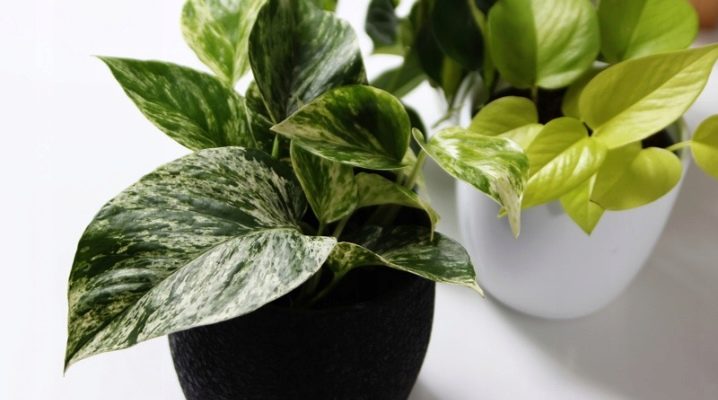
Nowadays, many gardeners and connoisseurs of beauty in the context of landscape design and the original design of various premises strive to learn everything about the epipremnum. The perennial vine is a member of the Aroid family.
According to the information available at the moment, the named genus can include from 8 to 30 species. The name itself translates as "on the trunks", which reflects the peculiarities of the existence of plants.
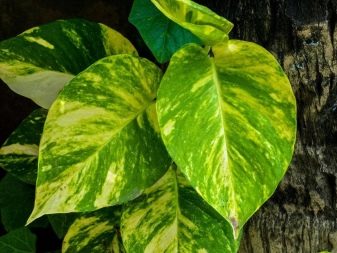
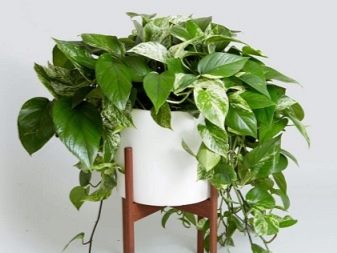
Description of the plant
Epipremnum is an evergreen herbaceous perennial plant. It is noteworthy that in its natural habitat, this semi-epiphyte can exist independently or parasitize on large trees. It feeds on the fibrous root system. In addition, the vine has many air roots, which, if necessary, easily form an additional system. One of the main features of epipremnum is the unique properties of the shoots. They are able to cling to any surface, as well as root along their entire length.
The leaf plates have heart-shaped contours and are thin or leathery. The foliage of adult plants reaches 0.6 and 0.4 m in length and width, respectively. During flowering periods, rather inconspicuous flowers form and bloom on the liana, which in no way affect the decorative qualities. They form inflorescences in the form of cobs, that is, they taper at the top.
It is important to note that the flowering of the vine itself occurs when the foliage matures, but at home it is extremely rare to observe it. Epipremnum fruits are berries with seeds inside.
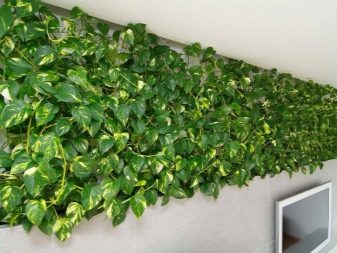
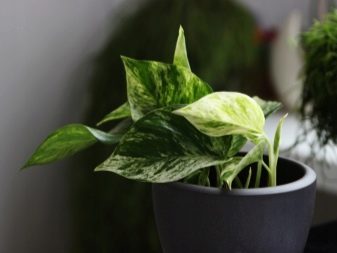
Varieties
Today, descriptions of many varieties of epipremnum can be found, including Marble Planet, Marble Apple, and Pinatum and Pinatum Mix. At the same time, the list of the most popular varieties of decorative liana includes the following.
- "Golden", which is currently the most common variety of the described plant. In America it is called "Golden Potos". And it often goes on sale under the name "Mosstock". It is important to note that in terms of decorative qualities this species is not inferior to breeding ones. The plant owes this to glossy and heart-shaped leaves with yellow spots and strokes.
- "Marble Queen", or Marble Queen. "Marble Queen" differs from the previous variety in the white and yellowish color of the leaf plates, which are literally speckled with green dashes (strokes).
- "Neon" - is one of the varieties of golden epipremnum. Its leaves have a uniform yellow-green color. One of the important features of Neon is its slow growth. This vine looks good when planted with other varieties.
- N'Joy - very bright epipremnum with spotty, relatively small, white-green leaves with an uneven surface.
- Godzilla - one of the unusual varieties of golden liana, which has twisted foliage.
- "Painted" (Pictus) - a species characterized by silvery specks on the matte surface of dark green leaf plates. The plant belongs to the genus Scindapsus and therefore it is correct to call it painted scindapsus.
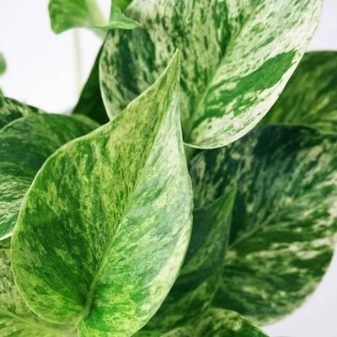
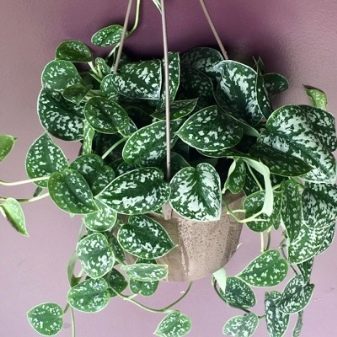
Growing
Experienced flower growers attribute unpretentiousness in combination with decorative appearance to the key advantages of epipremnum. This plant requires bright, but diffused light.Based on this, vines will grow and develop better in houses with a western exposure. When grown at home, room temperature will be quite comfortable. However, it is worth focusing on protection against drafts, which can lead to the death of the plant.
Given this feature, it is strongly not recommended to move the bushes to the garden or to the balconies for the summer. The best solution would be to organize regular ventilation of the room. Another important point in growing is periodic transplanting. If young animals need it annually, then older representatives do not need to frequently change capacity and soil.
This procedure is carried out, as a rule, with an interval of 2 years. The fact is that the roots of the liana are entwined with an earthen lump, and a transplant will be necessary if they are overgrown.
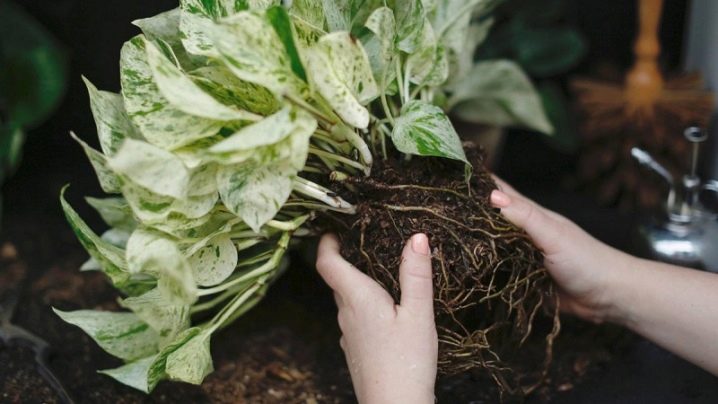
Location
It is important to consider that green-leaved species are not overly demanding on lighting. These plants thrive in both bright light and light shade. The situation is different when it comes to growing variegated varieties that need excessive lighting. In the absence of such, the plant noticeably loses its decorative effect. But regardless of the peculiarities of the species, when choosing a place for keeping the epipremnum, it is important to take into account the negative effects of direct ultraviolet rays on it.
Prolonged exposure to the scorching sun will lead to the fact that the foliage of the creeper will fade and lose its elasticity. The next stage will be flying around the leaves, and sometimes slowing down the growth of shoots. The best place for a vine will be a window on the east or opposite (west) side.
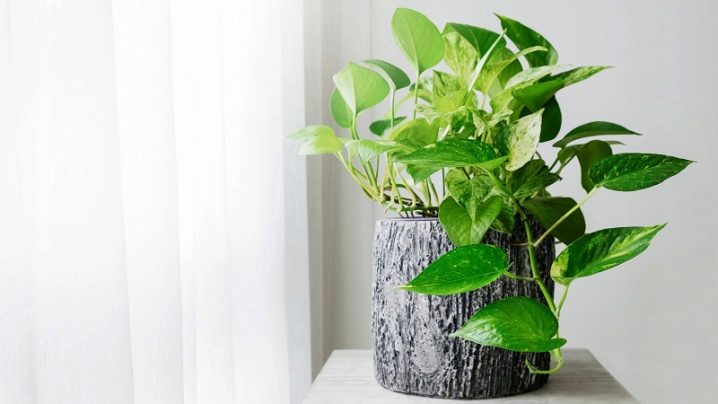
The soil
The soil for exotic flora should be moisture and breathable. A universal flower soil mixture is quite suitable for epipremnum. Some gardeners prefer such purchased options as "Saintpaulia", "Begonia", "Zhivaya Zemlya", "Cactus Plus" and others. An alternative to them can be a homemade substrate, which includes:
- peat - 1 part;
- turf soil - 1 part;
- humus - 1 part;
- coarse sand - ½ part.
It is recommended to lay a drainage layer on the bottom of the pot and any other container.
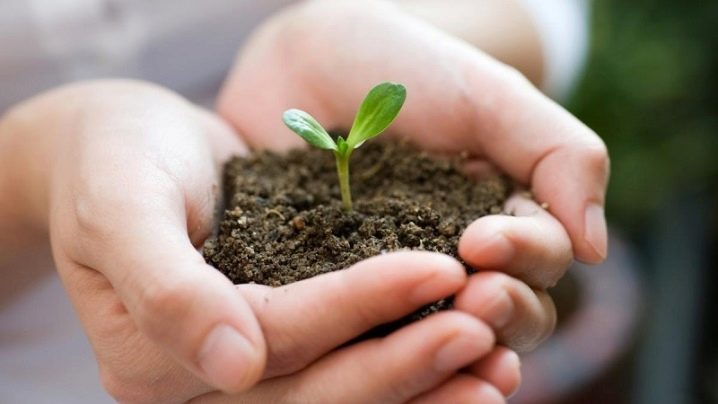
Landing rules
The procedure for planting seedlings, as well as transplanting the described plants at home, is as follows.
- A pot of medium depth and rather wide is selected. It is important to take into account that epipremnum has an underdeveloped root system, and therefore does not need a deep capacity.
- A drainage layer of broken brick or expanded clay is laid. It is important that there are several holes in the bottom of the container for the outflow of excess moisture.
- A suitable soil is selected.
- A seedling pre-soaked in water for several days is placed in the ground to a depth of 3-5 cm.
- The missing amount of soil mixture is poured from above.
- At the final stage, irrigation is carried out.

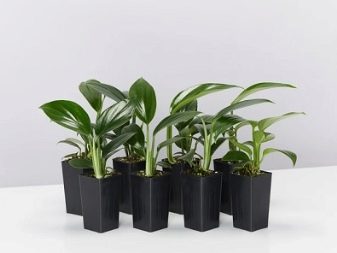
Watering
From the very beginning, it should be noted that watering the soil is required if its top layer is well dried. It is important to remember here that epipremnum is one of those plants that tolerate short-term drought more easily than regular and prolonged stagnation of moisture in the root area. Systematic waterlogging of the soil often leads to the development of dangerous diseases. A striking symptom of stagnation and a reason for reducing the frequency and abundance of irrigation will be the appearance of droplets on the lower surface of the leaf plates.
In the winter months, air humidity is predictably lower due to the operation of various heating devices and systems in the premises. Naturally, in such conditions, the liana requires additional moisture. In this case, one of the mandatory measures should be regular spraying with water using a spray bottle. Similar actions will be relevant on especially hot summer days.
It is important to use soft, filtered, thawed or settled water for at least a day when watering and humidifying.
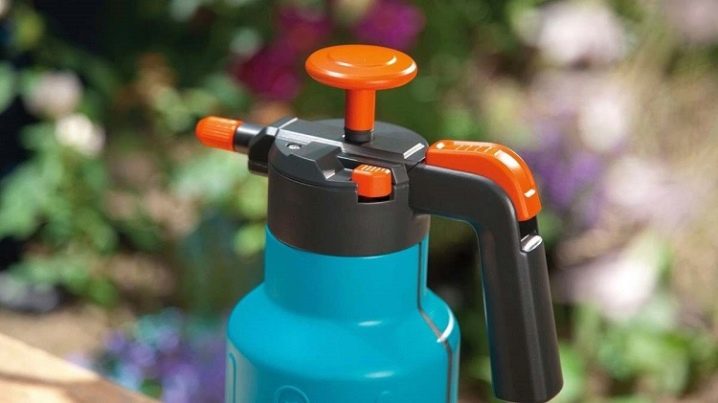
Top dressing
First of all, it is important to note that the active growth of the described liana falls in the spring-summer period. It is at this time that the plant needs fertilizer. Liquid preparations for flowering crops are used as effective dressings. In this case, you should not over-fertilize the soil. During growth, fertilizing is applied weekly. In the autumn and winter months, even with minimal activity, it is necessary to fertilize the soil. Naturally, they do it much less often.
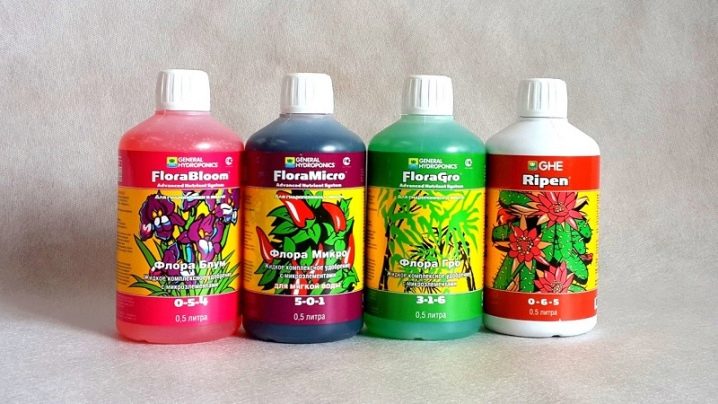
Reproduction
In room conditions, epipremnum is bred mainly in one of the following vegetative methods.
- By dividing the escape. This technique is rightly considered the most difficult. It is necessary to carefully cut off a piece of the stem and divide it into parts, each of which should have at least one leaf. These pieces of shoot are planted in soil for rooting and placed in a dark place. It is important to remember that the planted stem sections cannot be watered or even moistened with a spray bottle.
- Layers. In this case, next to the plant, it is necessary to place a container with soil mixture and lay an epipremnum shoot on its surface. The latter is fixed with pins in one position and sprinkled with soil on top. As soon as their own roots grow and get stronger, the layers can be separated and planted separately for further growth and development as an independent unit.
- By cuttings. Apical cuttings are successfully used by flower growers, for the preparation of which the tops of the shoots are carefully cut off with 2-3 leaf plates on each. For rooting, the future planting material is placed in containers filled with a substrate, which includes equal proportions of peat and sand.
In practice, it is cuttings that are most often used. In doing so, it is important to remember to create an enabling environment. So, rooting will occur faster at temperatures from +22 to +25 degrees. In parallel, the cuttings require regular moistening, carried out through a spray bottle. In most cases, the root system begins to form in 2-3 weeks.
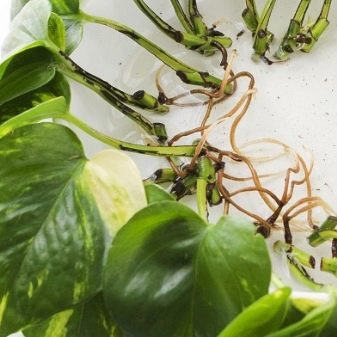
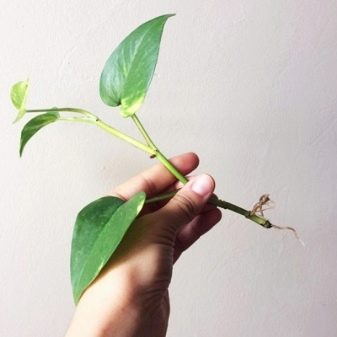
Diseases and pests
Unfortunately, many modern flower growers, almost all varieties of epipremnum are characterized by low resistance to fungal diseases. That is why it is important to focus on observing the rules for watering the plant. Temperature fluctuations and the excessive presence of nitrogen in the soil will be equally important factors. Ignoring fairly simple rules is likely to lead to the formation of destructive root rot. Another trouble is botrytis, that is, a disease whose symptoms are reddening of the leaf plates. Harmful bacteria develop actively in high humidity.
In the overwhelming majority of cases, the cause of the painful state of the plant is errors in caring for it, namely:
- lack of lighting, which leads to yellowing and leaf fall;
- exposure to direct UV rays, leading to fading of the color of the leaf plates;
- excessive watering, resulting in dark spots on the foliage;
- lack of moisture, provoking drying of the tips of the leaves.
In addition to diseases, attention should also be paid to the risks of pest attacks. So, spider mites, scale insects and thrips can appear on the liana. We are talking about sucking parasites, which, damaging shoots and foliage, feed on the plant. The attack of such pests leads to lethargy and significant weakening of the epipremnum, accompanied by active yellowing and foliage falling. Today, insecticide solutions are effective means of combating scale insects and thrips. When attacking spider mites, the most rational solution would be to use acaricide.
At the moment, all drugs can be purchased at any specialized store, the main thing is to use them in strict accordance with the manufacturer's instructions.



























The comment was sent successfully.